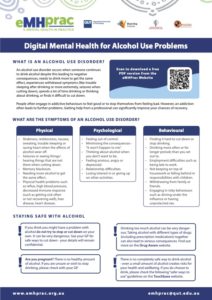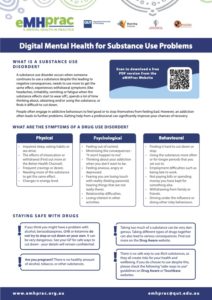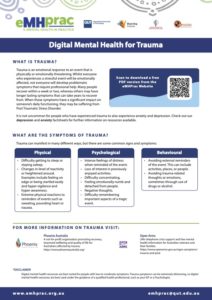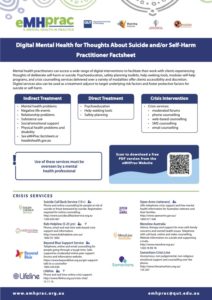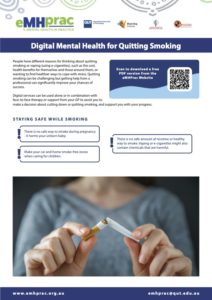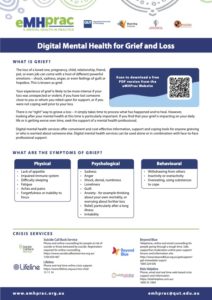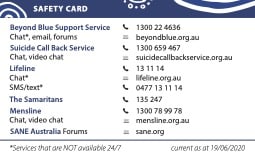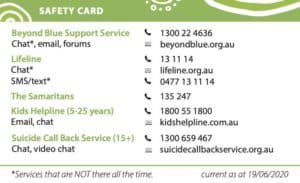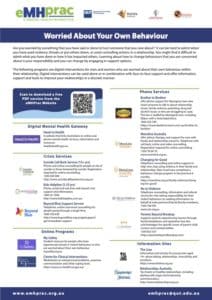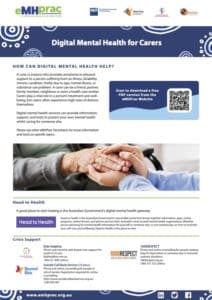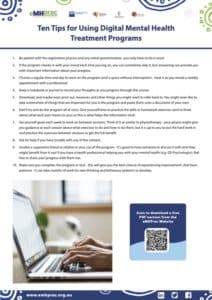Written by Shelley Appleton, D.Psych(clin), Clinical Psychologist, eMHPrac team
Digital mental health interventions often address singular mental health disorders and are recommended for consumers with mild to moderate symptoms. In reality, mental health practitioners often see consumers with complex, severe, or chronic presentations. Over a quarter of Australians reporting a mental health disorder in the last 12 months experienced severe functional impairments, a suicide attempt, significant substance dependence or a diagnosis of bipolar I disorder (Australian Institute of Health and Welfare, 2022). So how do practitioners who work in the real world use digital interventions and what relevance do they have for work with more severe and complex presentations such as personality disorders, bipolar disorder, psychosis or substance use?
If the concept of using digital interventions in your practice is new to you, it is normal to be sceptical before adopting it as an approach, particularly when you aware of your consumers’ vulnerability and are motivated to provide the best outcomes. Practitioners might think that digital mental health interventions do not have a place in a setting where the therapeutic relationship with the consumer is key to their outcome, clinical judgement is often called into play, and strong countertransference reactions and high-risk situations are common. Some clinicians believe that outcomes for consumers with severe and complex mental health problems are exclusively related to medication adherence or the therapeutic skill of a practitioner. Observation, listening between the lines, and sitting with suffering are all very human components that seem impossible to replicate through the use of technology. It might be difficult to raise the idea of using a digital intervention with a consumer for fear that they feel rejected from a face-to-face service or turned away (Scott et al., 2022). Or simply, you might not know what digital interventions are out there or how to find relevant, evidence-based interventions that address the presentations you commonly see in your practice. You might think of digital interventions as an “instead” option, rather than a tool to supplement existing face-to-face or telehealth therapies with more severe presentations.
So, What Does the Evidence Say?
Digital mental health can be integrated into existing face-to-face or telehealth services in what is known as “blended care”. This involves using digital interventions in a supplementary way (e.g. Titzler et al., 2018). Blended care can look like a mental health practitioner overseeing the use of an online program between session, supplementing face-to-face therapy with digital tools, linking consumers to peer support forums, or phone/SMS/email services to bridge existing treatment sessions. Blended care has the potential to save practitioners time, increase the effectiveness of existing treatments, improve consumer adherence to therapy, assist in preventing relapse, and increase treatment engagement through enhanced choice and flexibility (Cerga-Pashoja et al., 2020; Erbe et al., 2017).
The evidence for digital mental health for people with severe and complex mental health problems is limited but exposes some areas of clinical utility. There is little evidence that digital mental health interventions improve primary outcomes of consumers with severe mental illness such as bipolar disorder, personality disorders or psychosis. However, digital interventions that are integrated into blended care might lead to some positive secondary outcomes, such as fewer positive symptoms, and improved social connection, help-seeking skills, medication adherence, and health literacy (Alvarez-Jimenez et al., 2014; Fortuna et al., 2020; Rotondi et al., 2010). There is evidence that users of digital interventions for substance use retain positive outcomes up to 6 months later (Giroux et al., 2017).
In addition, the acceptability of digital interventions amongst consumers with severe mental health problems is high (Berry et al., 2016). Digital interventions might overcome some traditional barriers to engagement with face-to-face therapies such as perceived stigma, judgement and shame, lack of trust, concerns around privacy, and poor social adjustment enabling consumers to be more open and honest. Digital mental health might allow consumers increased access to information and tools with increased autonomy, as well as real-time progress monitoring (Tremain et al., 2020).
Engagement Considerations
Digital mental health interventions are not for everyone. An assessment of whether an intervention offers clinical utility and is appropriate and safe is primary. Does the consumer have a device and access to an internet connection? Are they able and willing to use it as a part of their treatment? Consumers with concerns around privacy and security may or may not be suitable candidates for digital interventions. Does the intervention allow the consumer to sign up or are there restrictions on who can use it? The content of digital interventions should be thoroughly reviewed prior to use to identify a resource using consistent language with the existing treatment, to avoid content that could be dangerous for people experiencing positive symptoms, or lacking safe-guards for people at risk of harm.
Additionally, consumers with severe and complex needs might have further barriers to engagement with digital technologies that need to be worked through. Severe symptoms, severe functional impairment and poorer cognitive functioning are associated with reduced engagement in digital treatments (Borghouts et al., 2021). People with higher symptom severity might benefit more from increased practitioner support with the use of digital technologies and could benefit from the involvement of a carer or support person where appropriate.
To find out more, take a look at the National Safety and Quality Digital Mental Health Standards.
What is eMHPrac and How Can They Help Me Get Started?
eMHPrac is a Government funded service offering training and support to health practitioners in the use of digital interventions. eMHPrac offers a variety of resources to help you get started, locate relevant services, understand the research evidence, and resolve practice issues.
Browse a directory of free, evidence-based mental health tools for tools that target your consumers’ needs:


Or peruse eMHPrac’s factsheets on a range of topics for consumers with severe and complex mental health problems:
Mental Health Issues
Audience
Other Useful Resources

Ask a question, problem-solve process issues or exchange useful resources.
For more resources and training in digital mental health visit www.emhprac.org.au
References
Alvarez-Jimenez, M., Alcazar-Corcoles, M. A., Gonzalez-Blanch, C., Bendall, S., McGorry, P. D., & Gleeson, J. F. (2014, Jun). Online, social media and mobile technologies for psychosis treatment: a systematic review on novel user-led interventions. Schizophrenia Research, 156(1), 96-106. https://doi.org/10.1016/j.schres.2014.03.021
Australian Institute of Health and Welfare. (2022). National Survey of Mental Health and Wellbeing. Mental health prevalence and impact. https://www.aihw.gov.au/reports/mental-health-services/mental-health/
Berry, N. Lobban, F., Emsley, R., & Bucci, S. (2016). Acceptability of interventions delivered online and through mobile phones for people who experience severe mental health problems: A systematic review. Journal of Medical Internet Research, 8(5), e121. doi: 10.2196/jmir.5250.
Borghouts, J., Eikey, E., Mark, G., De Leon, C., Schueller, S.M., Schneider, M., Stadnick, N., Zheng, K., Mukamel, D., & Sorkin, D.H. (2021). Barriers to and facilitators of user engagement with digital mental health interventions: Systematic review. Journal of Medical Internet Research, 23(3), e24387
doi: 10.2196/24387
Cerga-Pashoja, A., Doukani, A., Gega, L., Walke, J., & Araya, R. (2020). Added value or added burden? A qualitative investigation of blending internet self-help with face-to-face cognitive behaviour therapy for depression. Psychotherapy Research, 1-13, 1–13. https://doi.org/10.1080/10503307.2020.1720932.
Erbe, D., Psych, D., Eichert, H.C., Riper, H., & Ebert, D.D. (2017). Blending face-to-face and internet-based interventions for the treatment of mental disorders in adults: Systematic review. Journal of Medical Internet Research, 19(9), e306.
Fortuna, K. L., Naslund, J. A., LaCroix, J. M., Bianco, C. L., Brooks, J. M., Zisman-Ilani, Y., Muralidharan, A., & Deegan, P. (2020). Digital peer support mental health interventions for people with a lived experience of a serious mental illness: Systematic review. JMIR Mental Health, 7(4), e16460. https://doi.org/10.2196/16460
Giroux, I., Goulet, A., Mercier, J., Jacques, C., & Bouchard, S. (2017). Online and Mobile Interventions for Problem Gambling, Alcohol, and Drugs: A Systematic Review. Frontiers in Psychology, 8, 954. doi: 10.3389/fpsyg.2017.00954
Rotondi, A.J., Anderson, C.M., Haas, G.L., Eack, S.M., Spring, M.B., Ganguli, R., et al. (2010). Web-based psychoeducational intervention for persons with schizophrenia and their supporters: one-year outcomes. Psychiatric Services, 61(11):1099-1105. doi: 10.1176/appi.ps.61.11.1099
Scott, S., Knott, V., Finlay-Jones, A.L. et al. (2022). Australian psychologists experiences with digital mental health: A qualitative investigation. Journal of Technology in Behavioral Science. https://doi.org/10.1007/s41347-022-00271-5
Titzler, I., Saruhanjan, K., Berking, M., Riper, H., & Ebert, D.D (2018). Barriers and facilitators for the implementation of blended psychotherapy for depression: a qualitative pilot study of therapists’ perspective. Internet Interventions, 12(1), 150-164.
Tremain, H., McEnery, C., Fletcher, K., & Murray, G. (2020). The therapeutic alliance in digital mental health interventions for serious mental illnesses: Narrative review. JMIR Mental Health, 7(8):e17204 doi:10.2196/17204

